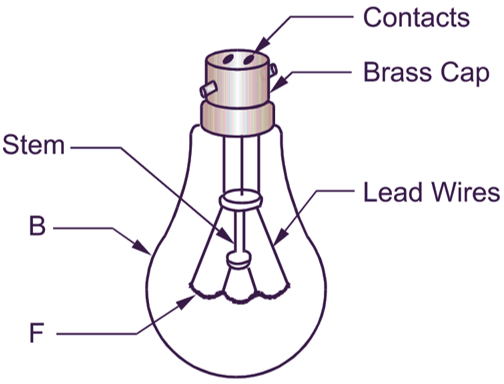In this topic, you study Incandescent Lamp – Working, Construction & Circuit Diagram.
Incandescent lamps work on the principle that when a filament of fine wire is maintained at incandescence (white-hot condition) by the passage of current, it emits sufficient energy in the form of light.

(a)

(b)

(c)
Fig.1 : (a) Modern gas filled incandescent lamp, (b) Coiled or helical filament, (c) Coiled-coil filament
Construction of Incandescent Lamp
Fig. 1 (a) shows the construction of the modern type of gas-filled incandescent lamp. It consists of a tungsten filament (F) placed in a glass bulb (B). Tungsten is used as filament material because it has a high melting point (3500°C), high specific resistance and a low rate of evaporation in addition to ductility and good mechanical strength. The glass bulb is filled with a chemically inert such as argon or nitrogen at about atmospheric pressure to further reduce the rate of evaporation and avoid oxidation. This increases the life and efficiency of the lamp. The filament is supported on wire hooks fixed on a glass stem and is normally in the coiled (helical) or coiled-coil (Figs. 1 (b) and Figs. (c)) form to reduce the surface area exposed to gas, thereby reducing heat loss due to convection. It also requires less space. The coiled-coil lamp higher efficiency than a single-coil lamp and requires less number Of supports for the filament. In small sizes upto 25 watts, the filament may be worked in vacuum.
Operation of Incandescent Lamp
When the current is passed through the tungsten filament, it is heated to incandescence (white-hot condition) which then starts emitting energy in the form of light.
Applications of Incandescent Lamp
These lamps are very commonly used for indoor lighting, flood lights for buildings, head lights for the vehicles, photographic and projection work. For applications requiring glare-free lamps, silica lamps with a milk-white diffusing layer Of silicon oxide spread over the internal surface of the glass bulbs are used. Carbon filament lamps are used as loading resistances. The commonly used ratings for the incandescent lamps vary from 10 to 1500 watts.
Advantages of Incandescent Lamp
- Cheapest among all types of lamps.
- Available in various shapes and shades.
- Operates at unity power factor.
Disadvantages of Incandescent Lamp
- Shorter life (about 1000 working hours).
- Much lower efficiency in comparison with discharge lamps i.e. lesser light output for given wattage.
- High heat radiation.
- They are very sensitive to changes in supply voltage. Efficiency and operating life of the lamp is dependent upon voltage fluctuations. Violent voltage fluctuations shorten the life of the lamp.